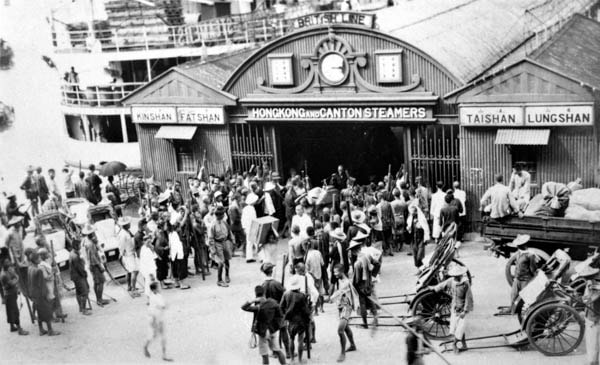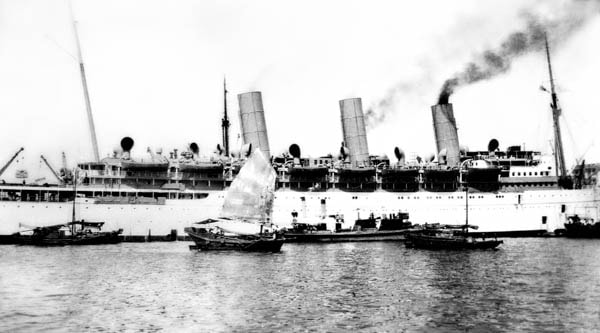Even though Hong Kong Island, Kowloon Peninsula and the New Territories had become a British colony, and Macao was a Portuguese possession, people in Hong Kong, Macao and mainland China were free to travel between these places and work in all three. No permit was required for people travelling between these places. As there was political instability in China, many Chinese came to work in Hong Kong and Macao. Together with the growth in trade between Hong Kong, Macao and China, there was a high demand for sea transport along the coasts of China in the early 20th century. The total number of passengers travelling between the coastal regions of China, Macao and Hong Kong by sea increased from 155,216 in 1900 to 171,982 in 1920. Because of the continuous growth in demand, many steamship companies operated services between the coastal regions of China, Macao and Hong Kong. The Hongkong Canton & Macao Steamboat Co. was the leading company running the Hong Kong, Guangdong and Macao line. It provided sailings twice daily between Hong Kong, Guangdong and Macao. There were other companies that operated the Hong Kong and Guangdong routes, including the Yuen On Steamship Company, the Shiu On Steamship Company, the Guangdong Navigation Company, China Merchant Steam Navigation Company, and Messageries Cantonnaises. Besides Guangdong and Macao, some steamship companies also provided sailings between Hong Kong and Wuzhou, Sanshui, Zhaoqing and Siyi. These companies included the West River British Steamship Company, the Sze Yap Steamship Company and China Navigation Company. Apart from steamship services, many passenger junks also provided services between the coastal regions of China, Macao and Hong Kong. Because of the strike-cum-boycott from 1925 to 1926 and the Japanese invasion in the 1930s, the total number of passengers travelling between the coastal regions of China, Macao and Hong Kong by sea decreased to 148,568 in 1931 and further decreased to 93,780 in 1937. Following the Japanese invasion of Guangzhou in 1938, all sea transport between the coastal regions of China, Macao and Hong Kong was suspended. [22]

Plate 4: Pier for steamship services between Hong Kong and the coastal area of China in Sheung Wan on Hong Kong Island
With the continuous improvements of the Suez Canal in the 1910s and 1920s, the opening of the Panama Canal in 1914, and general technological advances, journeys from Europe to Asia and from America to Asia were shortened. This facilitated trade between Hong Kong and foreign countries, and also led to a high demand for international passenger sea transport. In 1900, 500,276 passengers travelled by ship between Hong Kong and other countries. The number increased to 1,509,557 in 1930. Due to the Great Depression and the Japanese invasion of China in the 1930s, passengers travelling by ship between Hong Kong and other countries dropped to 759,720 in 1939.[23]
From 1899 to 1940, many passenger liners sailed to Hong Kong from all over the world for trade and travel. The Peninsular and Oriental Steam Navigation Company, Nippon Yusen Kaisha, the Ocean Steam Ship Company, the China Mutual Steam Navigation Company (Blue Funnel Line), and Messageries Maritimes were the major companies operating passenger and freight services between Hong Kong and Europe. Canadian Pacific Steamships Limited, the Dollar Line, the American President Line, and Nippon Yusen Kaisha were the major operators for the Hong Kong and North America routes. Eastern and Australian, Nippon Yusen Kaisha, and Australian and Oriental provided sailings to Australia. The Indo-China Steam Navigation Company Limited and the China Navigation Steam Ship Company operated routes to the ports of China. The Java-China-Japan Line and the Royal Packet Navigation Company (KPM Line) provided services to Java in Indonesia and Indo-China. Osaka Shosen Kaisha, Toyo Kisen Kaisha and Nippon Yusen Kaisha provided services to Japan.[24]
Notes:
- [22]外務省通商局:《香港事情》(東京:啟成社,大正6年[1917]),頁107-123; Annual Report on the Social and Economic Progress of the People of the Colony of Hong Kong, 1931, p. 24; Report on the Social and Economic Progress of the People of the Colony of Hong Kong, 1938, pp. 40-41; Endacott, A History of Hong Kong, pp. 288-294; Reports of the Harbour Master, 1900, 1920; Reports of the Harbour Master and Director of Air Services, 1931, 1937, 1938, 1939.
- [23]Report of the Harbour Master, 1900; Report of the Harbour Master and Director of Air Services, 1939.
- [24]外務省通商局:《香港事情》,頁107-123;Annual Report on the Social and Economic Progress of the People of the Colony of Hong Kong, 1931, p. 24; Report on the Social and Economic Progress of the People of the Colony of Hong Kong, 1938, pp. 40-41.
Part 1 Chapter 4.3 - The development of regional and international passenger transport



